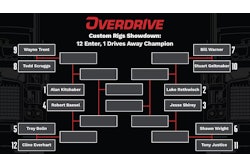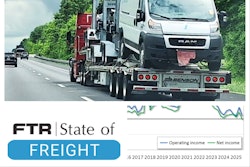Circus life isn’t for everyone, and neither is trucking. Truckers and circus performers are nomadic in nature, so it’s no wonder that many circuses are transported by semis.
The Kelly Miller Circus of Hugo, Okla., has five red Freightliners and smaller show trucks with the circus logo that moves its equipment. The performers travel in RVs as they move from one town to another. Their shows can be seen in the Midwest, South and Northeast, and in larger cities such as Dallas, Chicago and New York.
A typical day for the Kelly Miller Circus begins when the trucks roll onto the lot at 7 a.m. The lead semi, driven by the general manager is the first to arrive, followed by the generator semi, the pole semi driven by the canvas boss, two animal semis that house three Asian elephants and hoof stock, and the cookhouse truck where meals are prepared for the crew.
The tractor-trailers are parked with the RVs and show trucks. The concessions stand and animal trucks are set up, and the crew starts raising the tent at 9 a.m. But on a cold, rainy March morning, the day wasn’t typical, and the crew was behind.
The truckers for the circus faced the elements as they tried to park their trucks in a soggy field beside Shield Elementary School in Glenn Heights, Texas. Chris Beckett, the show’s 24 Hour Man, arrived first and tested the ground. There was a discussion about whether to move the show six miles down the road to a Wal-Mart parking lot or try the soft, wet ground. Each semi has pull hooks so that Viola, the elephant, can pull them out when they’re stuck in soft ground.

“Always be friendly to the elephant man because he can make you lose a front end,” Beckett says and laughs.
Representatives from Wal-Mart couldn’t be reached in time, and a decision had to be made. After reassurance from the city that the field would be repaired if marred too badly, Beckett directed the trucks into the parking lot.
The truckers helped park the circus vehicles and began working to raise the big top. The crew worked in the pouring rain, and their boots were caked in mud. The ground was too soggy for the work trucks to roll onto the field, so Nina, a 7,000-pound Asian elephant, was harnessed to the stake truck. She pulled the truck in a circle while the crew drove wooden stakes into the ground. If the ground had been dry, steel stakes would have been used.
At 9:30 a.m., Viola, a 10,000-pound Asian elephant, was brought out to help raise the big top. She holds up the test as the crew pulls the tent sides in place. Her last duty is to pull the ceiling pole that raises the 5,000-pound tent.
The circus runs seven days a week and holds two shows a day for 33 weeks. It travels to 222 cities a year in 16 different states. Each year, its first show is held in Hugo, Okla, the location of its headquarters. On their months off, the crew, performers and truckers find other jobs, and the equipment is maintained.
Driving the Circus
Roy Wells has been the show’s animal trainer and driver for six years. He says his job is different from most truckers because he has to be cautious of the animals standing in the trailer, and he has to make frequent stops along his route.
“We take it slow around corners, almost to a stop,” he says. “We also have to stop to water and care for the animals. It’s not the same as hauling general freight.”
Once, Wells broke down and had to wait overnight at a truckstop in South Carolina while his engine was rebuilt. He tied the elephants near the fuel island and laughed when he saw the truckers’ faces as they pulled in that night.
“The headlights would flash on them, and I could see the shocked looks on their faces,” he says. “They looked like they couldn’t believe what they saw.”
Wells likes driving because it gives him plenty of time to think, but his primary concern is for the animals. “Driving is a necessary evil, but I like it,” he says. “My priority is to take care of the animals and deliver them safely.”
Katie Naughton, who drives for the Yankee Doodle Circus out of Greenville, N.Y., says that a driver gains a lot of attention when hauling circus animals. When people ask what’s inside the circus trailers, her father has a unique message.
“He tells them it’s the next winner of the Kentucky Derby,” she says. “Then he shows them the miniature horses, and they laugh.”
Naughton has driven six years for her family’s circus, and she is also the manager of the company and road manager of the show. She hauls eight miniature horses and has to stop every four hours to water and feed them.
The show has three red Kenworths and seven RVs for the performers. The show covers 125 cities in the Northeast, metropolitan New York and Boston.
“I love it,” Naughton says. “I’m on the road and see different people every day. Most of the people are nice. Once a week, I see the show. Drivers have other jobs to do when they aren’t driving. There aren’t many jobs with the circus that don’t require dealing with people. If you don’t mind being around people, it’s a great job to have.”
Justin Loomis has been the ringmaster for the Kelly Miller Circus for two years. He says the process is well organized and the truckers are professional. “At the end of the last show, two elephants, Viola and Libby, pull the stakes up from the ground. It’s good exercise for them,” Loomis says. “Then, the truckers and crew load the tents and equipment so that we’re ready to pull off the lot the next morning. We couldn’t do this without their help.”
Hector Perez is the canvas boss. He drives the pole truck that holds the bleachers, poles and tents and is one of the first semis on the lot. He is responsible for setting up the tent and helping park vehicles. Perez says his job is predictable, except when it rains.
“The worst part of this job is dealing with the elements like wind and rain,” Perez says. “Today is a different day and will be a long day. Regular days are easy.”
Routing and directing the trucks
The drivers get a route slip each morning before leaving the lot of the previous show. Beckett arrives in the town 24 hours before the show trucks arrive. He decides on the best route into town and starts placing arrows along the route to lead the drivers in.
“I put down 20,000 to 25,000 arrows a year,” Beckett says.
When choosing the route, Beckett looks for trees that might obstruct the driver’s view and for low hanging power lines. He also looks for wide roads so that traffic can pass without the trucks having to pull over on the side of the road.
“Not only is it dangerous for the equipment, it’s dangerous for the gawkers,” Beckett says. “In New York, I have to measure the bridge heights because they are usually lower than what it reads on the bridge.”
Drivers get three sets of arrows along the road warning them a turn is coming up. First, the drivers see one arrow pointing in the direction of the turn. Approximately one half mile from the turn, two arrows are placed signaling the turn. At the actual turn, three arrows are placed pointing in the direction of the turn. After completing the turn, drivers see one arrow pointing straight up, signaling they’ve successfully made the turn.
“The last is a confidence arrow,” Beckett says.
As the drivers approach a bumpy railroad crossing or road, they’ll see up to three arrows pointing down. The number of arrows used depends on how rough the road or railroad crossing is.
“These arrows mean to slow down,” Beckett says. “If it’s an extremely rough road or railroad crossing they need to slow to almost a crawl so the animals won’t be shaken up. Logistics is important to our show.”
The drivers have the same responsibilities as other over-the-road drivers and keep daily logbooks. Parking is done by hand signals, and directions aren’t yelled out. For the circus drivers, the signal most drivers see from the public urging them to blow the air horn means the ground is soft.
“The drivers don’t look in the mirror,” Beckett says. “They’re good enough to back a semi up in the dark within inches of another vehicle. If I mess up with the directions, they know what to do.”
In the event of severe weather with high winds, the big top is attached to the semi. The tent is down, and the equipment is loaded within 50 minutes after the last show. Last year the staff broke its record time. There was a tornado warning, and the show was loaded in 45 minutes.








